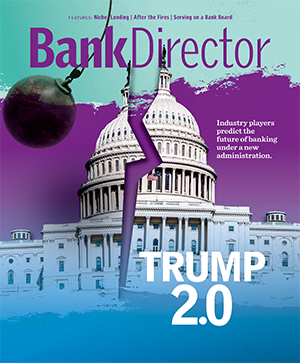
A Common-Sense Approach to Board Evaluations
The 2002 Sarbanes-Oxley Act requires large banks to evaluate their board of directors regularly. Very few smaller banks engage in routine board evaluations, and those that attempt to do so generally evaluate them on an ad-hoc basis. Often, their position is that if itu00e2u20acu2122s not required, why should directors take the time for a comprehensive, regular board evaluation? The answer is simple: Because they canu00e2u20acu2122t afford not to.There is a direct and positive correlation between the performance of a bank and the performance of its board of directors. Maximizing board performance is, therefore, crucial for any bank that wants to grow and achieve the goals identified in its strategic plan.
If a board is to fulfill its obligation of accountability for the institution it governs, it must also be accountable for its own performance. And, if it holds management to high standards, it must demand the same of itself.This means participating in a board evaluation process that is conscientious, structured, and regular, none of which need be complicated to be effective.
Best practices for best boards
Every board should evaluate its performance once a year. If a board has not engaged in this kind of thorough assessment in the past because directors have been afraid of offending each other, the first step is to set aside any such considerations and make the decision to do what is necessary for the greater good of the organization. Jumpstarting the process generally requires a championu00e2u20ac”either the chair or another board member who has served on other boards and recognizes the need for the evaluation.
Step 1: Select a set of criteria for evaluation.
Prior to conducting a board performance review, the board should identify the criteria for evaluation and commit them to writing.To ensure a balanced view, include both tangible metrics and intangible (soft, but not vague) measures. Keep both tangible and intangible criteria specific rather than open to interpretation.
Among the first criteria might be earnings, capital ratios, asset quality, quality of exams, technical exceptions, past-due loans increasing, and similar red flags.
The second category assesses the contributions of the board members themselves. For example, what is each directoru00e2u20acu2122s contribution to business development? To what extent do individual members participate in board meetings and committees? Do they contribute independent thought and fresh ideas, or do they simply agree with the chair? The ideal board is a group of astute businesspeople with a wide variety of backgrounds and experiences who can contribute innovative and diverse ideas to make sure the board considers issues from every possible angle.
For example, in looking at participation during board meetings, a related point for evaluation is how well directors prepare for meetings.To what extent do directors study premeeting informational packages, or are meetings largely devoted to reading these materials, leaving little time for actual deliberation? An engaged group arrives at each meeting well prepared for discussion and debate.
Once criteria have been selected, scorecards and a matrix help track performance and keep everyone focused on the real issues without letting items become too personal. One successful practice is to create a form that allows each director to rank the boardu00e2u20acu2122s performance on the selected criteria using a scale (excellent to poor, 1-10, etc.) or by answering yes/no to performance questions and providing additional comments. Each director submits the completed form to the board secretary at least two weeks before the evaluation meeting, and the secretary compiles the answers into a summary report.
Step 2: Engage an independent third party to facilitate the process.
Although this step is optional, the use of an independent facilitator may be a more effective, accurate way to review board performance. Experienced facilitators know what to look for, how to stimulate discussions of u00e2u20acu0153softu00e2u20ac issues whose impact is difficult to gauge, and have the courage to ask the tough questions related to public scrutiny. In addition, they are generally skilled at communication and mediation. Of course, industry and market expertise are also chief considerations, as well as legal knowledge concerning board responsibilities and governance structures.
Itu00e2u20acu2122s important for outside facilitators to be given time to prepare for the evaluation. For example, if an evaluation session is scheduled for July, engage the facilitator in January and have him or her observe all meetings in the interim.This gives the facilitator time to review reports, gather information, and watch board members interact.
Step 3: Meetu00e2u20ac”discussu00e2u20ac”plan.
The central focus of the evaluation is a meeting (an offsite retreat works best) at which the board candidly discusses its performance in every aspect of the selected criteria. An agenda that lists the order of criteria to be assessed helps keep the discussion on track. Whether or not a third party guides this process, itu00e2u20acu2122s important for boards to understand there is nothing wrong with having conflicts as long as issues are brought to the table without getting personal. Diversity of perspective leads to the best solutions to problems and challenges. Knowing where each director stands gives the board the opportunity to work toward common ground and consensus. Even when issues are seemingly irresolvable, a common denominator will ultimately emerge and allow decision making to move forward.
Donu00e2u20acu2122t assume that, as the saying goes, u00e2u20acu0153If itu00e2u20acu2122s not broken u00e2u20acu00a6 ,u00e2u20ac it need not be evaluated. For example, just because a bank has captured 50% of the market does not mean it canu00e2u20acu2122t continue to improve. Perhaps the market has changed or a new factory has moved to town, presenting a unique opportunity to grow.
Also, donu00e2u20acu2122t avoid the elephant in the room. Has the board tolerated a substandard CEO for many years? Is the board chair too dominant, leaving no room for other ideas? Is there a loan customer nobody wants to talk about? Are there board members who are not carrying out their fiduciary responsibilities? Is there insider abuse? Is a director willing to lower the banku00e2u20acu2122s standards to permit lending to cronies? Does a director have personal issues with a colleague or the CEO that cloud his or her objectivity? It takes courage to address such sacred cows, but remember, board performance has a direct impact on bank performance.
At the completion of the meeting, create a report detailing action plans and timelines.To each action plan, assign a director or committee who will be responsible for carrying it out and reporting back to the full board on accomplishments or obstacles.
Step 4: Execute the plan.
Optimally, boards work as a team, with individuals or committees carrying out tasks as assigned. In some cases, the action plan may call for changes to the way meetings are conducted; in other cases, remedial action occurs outside of board meetings. For instance, if the evaluation indicates some board members are not actively participating in meetings, have the board chair call on them in each meeting to solicit input on each agenda item until they have learned to engage on their own. On the other hand, if the reason for their lack of engagement proves to be insufficient familiarity with banking terminology or processes, the action step may call for assigning an experienced board member as a mentor or referring them to outside training programs.
If board members discover during the assessment process that they have difficulty understanding the reports they receive from management, one action step would be to assign an experienced board member to educate management on how to format and present reports to board members. Generally, directors do not need volumes of fine detail, but only the 30,000-foot view essential for effective governance. However, they do need to be able to recognize when more detail is needed to make effective decisions.
Similarly, if the evaluation shows that the board spends too much time listening to the CEO reading reports, the action plan would call for educating the CEO on what the board needs to know. One solution would be to ask the CEO to send his or her report to all board members prior to each meeting so they can study it and come prepared with questions.
Step 5: Follow up.
A process to monitor progress is an indispensable part of improvement in any area. Use a matrix to track accomplishments and schedule follow-up meetings for the full board in three and six monthsu00e2u20acu2122 time, after everyone has had a chance to work through the challenges. Committees assigned to individual action steps should meet more frequently. Also, if an individual board member is expected to complete an assignment, have a colleague or the chair frequently check in with him or her and offer support. If the follow-up meetings show that progress is not being made in a certain area, find out why and remove the obstacles. Or, if it appears that the course of action chosen was incorrect, discuss alternate steps that will lead to the goal.
Continuing education
While the CEO and other management team members are involved in banking initiatives and operations on a daily basis, directors may only be exposed to such matters during committee and board meetings. Ongoing training and education are the keys to helping directors better perform their fiduciary responsibilities. There are a variety of educational opportunities provided by state and national banking organizations. For example, the American Bankers Association, the Independent Community Bankers Association, and many statesu00e2u20acu2122 associations provide excellent board training courses, and bank regulatory agencies also have outreach programs. Some universities offer excellent directorsu00e2u20acu2122 colleges, but these can be expensive and require a greater time commitment.To achieve optimal performance for your board, the main goals should be to pursue continuing education, establish a comprehensive evaluation process, and have the courage to ask tough questions with regular follow-up. Only then can a board expect optimal performance from management as well.

Join OUr Community
Bank Director’s annual Bank Services Membership Program combines Bank Director’s extensive online library of director training materials, conferences, our quarterly publication, and access to FinXTech Connect.
Become a Member
Our commitment to those leaders who believe a strong board makes a strong bank never wavers.

